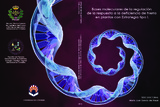Mostrar el registro sencillo del ítem
Bases moleculares de la regulación de la respuesta a la deficiencia de hierro en plantas con Estrategia tipo I
| dc.contributor.advisor | Pérez Vicente, Rafael | |
| dc.contributor.advisor | Romera Ruiz, Javier | |
| dc.contributor.author | García del Rosal, María José | |
| dc.date.accessioned | 2013-06-18T07:34:02Z | |
| dc.date.available | 2013-06-18T07:34:02Z | |
| dc.date.issued | 2013 | |
| dc.identifier.uri | http://hdl.handle.net/10396/10463 | |
| dc.description.abstract | El hierro (Fe) es un microelemento esencial para las plantas, que interviene en procesos fisiológicos tan importantes como la fotosíntesis, la respiración y la asimilación de nitrógeno (Marschner 1995). El hierro también es un nutriente esencial para animales y humanos, que lo obtienen en última instancia de las plantas. La deficiencia de hierro produce clorosis férrica, que se manifiesta principalmente como un amarilleamiento internervial de las hojas más jóvenes y da lugar a una disminución de la fotosíntesis y de la acumulación de materia orgánica, lo que origina un descenso del crecimiento y de la productividad de los cultivos afectados (Chaney 1984). La clorosis férrica se origina como consecuencia de la baja disponibilidad del hierro en el suelo para las plantas. Para facilitar la absorción de hierro del suelo, las plantas han desarrollado diferentes estrategias. La Estrategia I es la que utilizan todas las plantas excepto las gramíneas (Romheld y Marschner 1986; Curie y Briat 2003; Kobayashi y Nishizawa 2012). La principal característica de las plantas con Estrategia I, en la que se centra este trabajo, es la necesidad de reducir el Fe3+, la forma más abundante en el suelo, a Fe2+, previamente a su absorción. Esta reducción ocurre mediante una enzima reductasa, localizada en la membrana de las células epidérmicas de la raíz, cuyo gen ha sido clonado en Arabidopsis (AtFRO2; Robinson et al. 1999), y en otras especies, como pepino (CsFRO1; Waters et al. 2007) y tomate (SlFRO1; Li et al. 2004). Una vez el hierro ha sido reducido, es transportado hacia el interior de las células a través de un transportador localizado en la membrana de las células epidérmicas de la raíz, cuyo gen también ha sido clonado en Arabidopsis (AtIRT1; Eide et al. 1996), y del que también se conocen homólogos en otras especies, como pepino (CsIRT1; Waters et al. 2007) y tomate (SlIRT1; Eckhardt et al. 2001). Estos genes de adquisición de hierro son regulados a nivel transcripcional por FIT (un factor de transcripción de tipo bHLH en Arabidopsis, cuyo homólogo en tomate es FER), que actúa conjuntamente con otros dos factores de transcripción, bHLHH38 y bHLH39 3... | es_ES |
| dc.description.abstract | Iron (Fe) is an essential microelement for plants that is necessary for important physiological processes such as photosynthesis, respiration and nitrogen assimilation (Marschner 1995). Iron is also an essential nutrient for animals and humans, who get it from plants. Low availability of soil iron to plants leads to iron deficiency which causes chlorosis.Iron chlorosis is manifested mainly as internervial yellowing of the youngest leaves, and leads to a decrease in photosynthesis and organic matter accumulation which results in a decrease in growth and productivity of affected crops (Chaney 1984). To facilitate the acquisition of iron from the soil, plants have developed different strategies. The strategy I is used by all plants except grasses (Römheld and Marschner 1986; Curie and Briat 2003, Kobayashi and Nishizawa 2012). The main characteristic of Strategy I plants, on which this work is focused, is the need to reduce the Fe3+, the most abundant form of iron in the soil, to Fe2+, prior to its absorption. This reduction occurs by a reductase enzyme, located in the membranes of the epidermal cells of the root, whose gene has been cloned in Arabidopsis (AtFRO2; Robinson et al. 1999), and other species, such as cucumber (CsFRO1; Waters et al . 2007) and tomato (SlFRO1, Li et al. 2004). Once the iron has been reduced, it is transported into the cells by means of an iron transporter located in the membrane of the epidermal cells of the root. The gene encoding the iron transporter has also been cloned in Arabidopsis (AtIRT1; Eide et al. 1996), and other species, such as cucumber (CsIRT1; Waters et al. 2007) and tomato (SlIRT1; Eckhardt et al. 2001). These iron acquisition genes are regulated at the transcriptional level by FIT, a bHLH type transcription factor in Arabidopsis, which is homologous to tomato FER, and acts together with two other transcription factors named bHLH39 bHLHH38 (Colangelo and Guerinot, 2004; Jakoby et al. 2004; Yuan et al. 2008; Bauer et al. 2007). 9... | es_ES |
| dc.format.mimetype | application/pdf | es_ES |
| dc.language.iso | spa | es_ES |
| dc.publisher | Universidad de Córdoba, Servicio de Publicaciones | es_ES |
| dc.rights | https://creativecommons.org/licenses/by-nc-nd/4.0/ | es_ES |
| dc.subject | Fisiología vegetal | es_ES |
| dc.subject | Plantas | es_ES |
| dc.subject | Deficiencia de hierro | es_ES |
| dc.subject | Clorosis férrica | es_ES |
| dc.subject | Absorción de hierro | es_ES |
| dc.subject | Estrategia I | es_ES |
| dc.subject | Reductasa | es_ES |
| dc.subject | Etileno | es_ES |
| dc.subject | Óxido nítrico | es_ES |
| dc.title | Bases moleculares de la regulación de la respuesta a la deficiencia de hierro en plantas con Estrategia tipo I | es_ES |
| dc.type | info:eu-repo/semantics/doctoralThesis | es_ES |
| dc.rights.accessRights | info:eu-repo/semantics/openAccess | es_ES |

